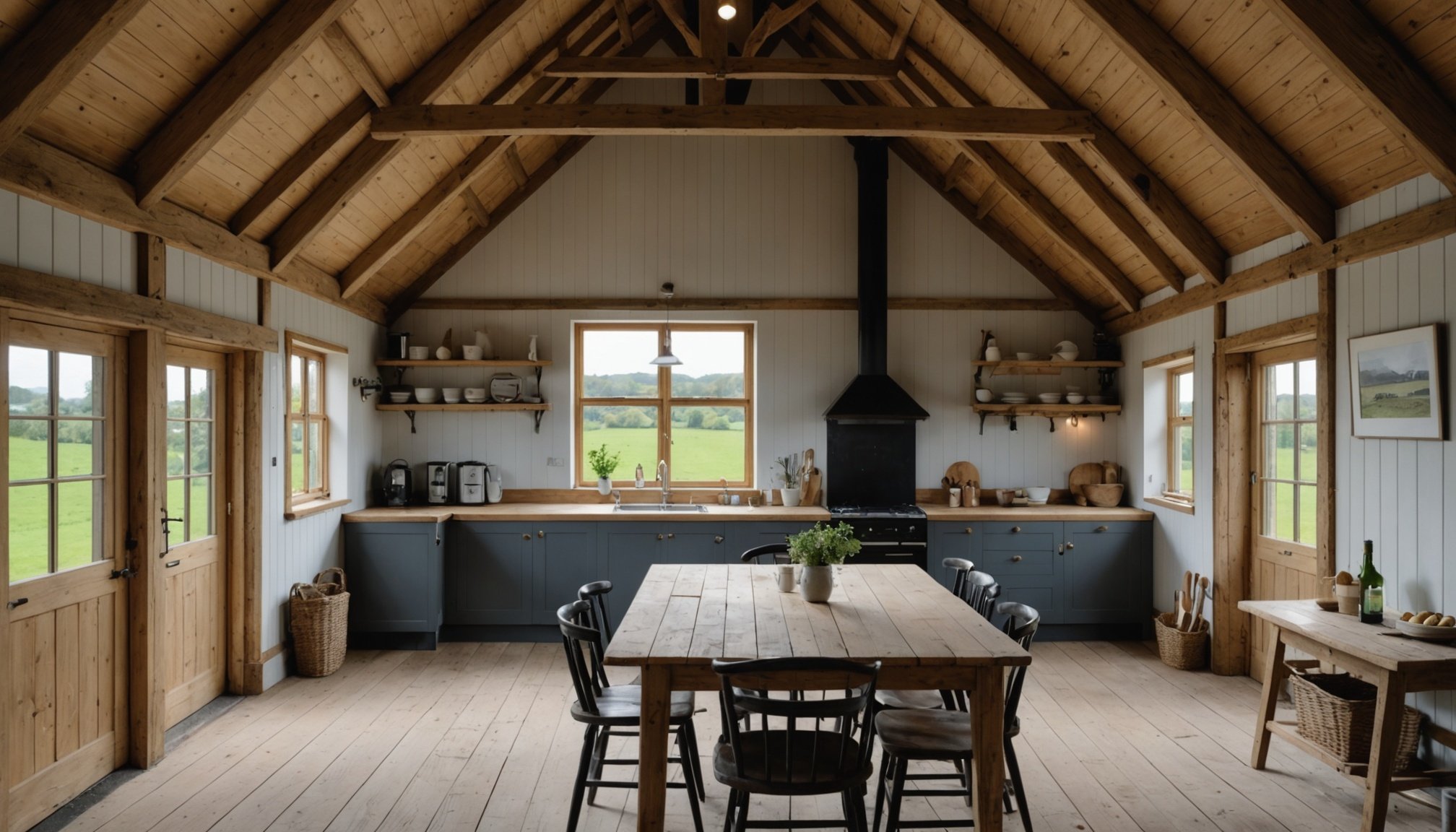Overview of Barn Conversion in Rural Wales
Converting a barn into a residential space in rural Wales offers a unique opportunity to blend modern living with traditional architecture. This process is not just about transforming a structure, but also about appreciating the unique characteristics of rural Welsh architecture, marked by its historical charm and robust construction. These barns, often made from local stone and wood, provide the perfect canvas for a cozy home that retains its rustic essence.
One of the main benefits of a barn conversion is the spacious open-plan living area it typically allows, which can be tailored to modern tastes while preserving historical features such as wooden beams and stone walls. This fusion of old and new creates a distinctive living experience.
A lire aussi : Brexit and Its Implications for Non-UK Residents: Navigating Property Ownership Challenges
The rural Welsh climate, characterized by abundant rainfall and mild temperatures, significantly impacts barn renovations. Insulation and weatherproofing become essential to create a warm, comfortable environment. The materials originally used, such as thick stone walls, provide natural insulation benefits, while new technologies can help enhance energy efficiency further.
By thoughtfully addressing these elements, a barn conversion not only provides a unique residency but also contributes to the preservation of local heritage in rural Wales.
A lire également : Essential Considerations for Selecting a Secure and Family-Oriented Neighborhood in Edinburgh
Key Design Considerations
Creating an inviting space with barn aesthetics requires thoughtful design tips. When modernizing, it is crucial to incorporate original architectural elements that capture the essence of a rustic environment. Retaining features such as exposed beams or stone walls can enrich the ambiance, blending cozy interiors with historical charm.
Selecting an appropriate color palette is another critical aspect. No other choice reflects the natural beauty of the Welsh countryside better than earthy tones paired with soft hues. These colors provide a serene backdrop, enhancing both warmth and coziness inside your home. Incorporating textures, such as wood and stone, further emphasizes the rustic feel you aim to achieve.
A well-planned floor plan is essential for maximizing natural light and space. If rearranging rooms, consider open concepts that allow daylight to sweep through, bringing a sense of airiness into your interior. Skylights or large windows provide ample sunlight, making spaces feel larger while highlighting the warm colors of your newly selected palette.
These considerations serve to craft a barn-inspired home that is not only aesthetically pleasing but also harmoniously integrates modern comforts with timeless rustic design. Embrace this opportunity to marry form and function while maintaining the authenticity of the atmosphere you cherish.
Navigating Local Regulations
When considering a barn conversion in Wales, understanding building regulations and planning permission is crucial. Barn conversions are unique renovations, often subject to specific requirements due to their structure and location. Obtaining the necessary permissions ensures that you stay compliant and avoid any legal hitches.
The importance of building regulations cannot be overstated. These regulations ensure safety, health standards, and energy efficiency. They cover various aspects such as structural integrity, fire safety, insulation, and ventilation. Failure to adhere to these can lead to costly delays or modifications.
Planning permission is another critical component. This is generally required for barn conversions due to the change in building use and potential impact on local aesthetics. In Wales, local authorities will assess the project’s suitability, considering factors like environmental impact, historical significance, and infrastructure.
Familiarising yourself with local guidelines is beneficial too. These guidelines provide a framework for designing your conversion in a way that aligns with community standards. They address aesthetics, environmental sustainability, and heritage conservation.
For assistance, resources such as the local council’s planning department or online portals offer guidance on legal requirements. Consulting with professionals who specialise in barn conversions can also provide insights and facilitate a smoother compliance process.
Choosing the Right Materials
When considering building materials, making sustainable choices is crucial. Opting for sustainable options not only benefits the environment but can also improve the long-term cost-efficiency of a project. These materials often require less energy for production and have a longer lifespan, reducing overall waste.
Local sourcing is another important factor. Using local suppliers not only supports the regional economy but also reduces the environmental impact associated with transporting materials over long distances. Additionally, local suppliers can offer insight into materials best suited to the local climate, enhancing energy efficiency and comfort.
For effective insulation and energy efficiency, materials such as cellulose, recycled denim, and sheep’s wool are excellent choices. These eco-friendly options can significantly enhance a building’s thermal performance, reducing the need for artificial heating and cooling.
When in pursuit of reliable materials, consider reaching out to community forums for recommendations on reputable local suppliers and contractors. Establishing connections with contractors who prioritise sustainable practices can ensure that your construction project aligns with green building standards.
By deliberately selecting materials and contractors that emphasise sustainability, individuals can achieve a balance between functionality, aesthetics, and environmental responsibility.
Insulation and Efficiency Methods
Insulation techniques are vital in maintaining energy efficiency and enhancing home comfort in barns and rural homes. A well-insulated space can dramatically reduce energy costs by preventing heat loss in the winter and maintaining cool temperatures in the summer.
Overview of Effective Insulation Methods for Barns
A variety of insulation techniques can be employed in barns. For walls and ceilings, spray foam insulation is highly effective due to its ability to seal small cracks and gaps. Fibreglass insulation, although traditional, remains a cost-effective option, especially in less extreme climates. Reflective insulation can be used in areas with significant sunlight exposure, as it helps deflect heat, thus maintaining a stable internal temperature.
Importance of Energy Efficiency in Rural Homes
Energy efficiency is increasingly significant in rural areas where utility costs can be higher due to remote locations. By employing efficient insulation techniques, homeowners can save on energy bills and reduce their environmental impact.
Tips for Enhancing Thermal Comfort Throughout the Seasons
To enhance thermal comfort year-round, consider adding a vapour barrier to prevent moisture build-up and rot. Seal gaps around doors and windows to prevent drafts. In colder months, ensure your barn’s heating system is compatible with your insulation methods for optimal efficiency.
Potential Pitfalls and Challenges
Converting a barn into a residence or workspace is no small feat, often riddled with renovation challenges. Beginning a project without thoroughly identifying and addressing common issues can lead to unforeseen complications. Often, issues like structural integrity and insulation inadequacies emerge. Addressing these early in the planning stages can prevent troubleshooting nightmares down the line.
Costs can spiral out of control if not managed vigilantly. Identifying hidden expenses, such as rewiring or plumbing overhauls, is crucial for effective budgeting. Prioritising tasks based on necessity can prevent overspending. It’s essential to have a contingency budget of at least 10% to accommodate unexpected challenges.
Studying case studies of successful barn conversions offers valuable insights. They illustrate the importance of planning, flexibility, and adaptability in the face of hurdles. For instance, one recurring lesson is the benefit of hiring specialists for unique problems, like ensuring adequate ventilation in a hayloft-turned-living space.
Managing renovation costs and common issues effectively demands a comprehensive approach. By understanding the full scope of potential challenges and preparing accordingly, one can transform a barn into a functional, modern space without succumbing to overwhelming obstacles.
Resources and Contacts
Navigating through a barn conversion project can be daunting, but the right contractor resources and local networks can make a world of difference. For those in Wales, a directory of local contractors and renovation specialists is invaluable. This directory helps connect you with professionals experienced in handling unique challenges associated with barn conversions. Leveraging their expertise can streamline the process and ensure high-quality results.
Apart from professional directories, engaging with online communities dedicated to barn conversions can be immensely beneficial. These platforms provide a space for enthusiasts to share ideas, seek advice, and offer renovation support. Participating in such communities can provide you with a wealth of real-world insights and tips from those who have already walked the path.
For those keen to broaden their knowledge and find inspiration, there are numerous books and articles offering detailed guides and innovative ideas. Recommendations for further reading include works by renowned architects and renovation experts, who provide inspiration through pictures and case studies of successfully converted barns. Such resources can not only guide your decisions but also fuel your creativity, allowing you to envision the full potential of your barn conversion project.











